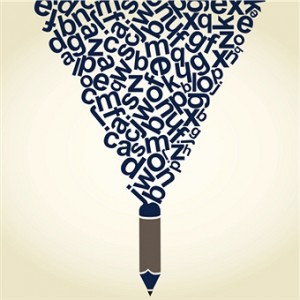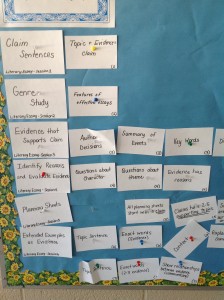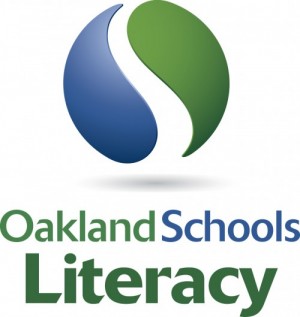 Several years ago, I developed an inquiry question that asked if students use the language of workshop. Because I consistently use the “ELA Speak” of mentor texts, seed ideas, and generating strategies, I questioned, do students know these terms and use them to forge work?
Several years ago, I developed an inquiry question that asked if students use the language of workshop. Because I consistently use the “ELA Speak” of mentor texts, seed ideas, and generating strategies, I questioned, do students know these terms and use them to forge work?
This work began with a checklist of workshop language that I wanted students to leave eighth grade knowing and using. I culled the list from the ELA Common Core State Standards, the MAISA Units of Study, and my lesson plans.
I decided I would look at summative writing work to evaluate students’ use of these skills. Additionally, I felt strongly about students having their voice heard, so final work was accompanied by a reflection which asked students to name skills they now had as writers, to give examples of these skills in their writing, and to set a goal for future use of these skills.
Originally, I modeled a reflection that focused on the end-product skills my writing showed, and student reflections did the same. In my example, I wrote a reflection on our opening unit about narrative poetry. In this reflection you can see how I named skills that are explicitly evident in the published final copy, such as craft skills (alliteration, repetition) and theme.
I shouldn’t have been surprised by this, but as I recorded language students named and used correctly or used and didn’t name, I realized that they were using the language of workshop, however, the tool I gave them to show this understanding didn’t allow everything to be shown. Namely, students didn’t name process skills or skills that students used to develop a final product, but I could see evidence of this work in my conference notes and in their drafts. In the next reflection, for the same unit a year later, you can see that I named generating and finding seeds as part of the journey to finding the topic I wrote about. Additionally, I explained several more skills that I used as a writer such as the overall structure and type of ending.
So, I made two changes. First, I more explicitly named the skills and associated lessons. I even hung these up in my classroom during the unit (pictured is literary essay unit).
Second, I created a model reflection that named process skills in addition to the end-product skills shown in my writing. I also exhibited this more thoroughly by writing in specific lines of my text that exhibit the traits I name in my reflection: Revised Reflection 2.
Now, student reflections named all of the skills learned and used. So, I know from reflections that students use the language of workshop in theory and in practice.
Reflections serve another purpose, though. As I grade the writing, according to a rubric which for me is a curricular model rubric assessing organization, content, and language use, I used student reflections as an accompaniment to reading the writing. For many language arts teachers, we take the student into account on these summative grades by considering, the growth that the student has achieved from conference suggestions, the specific use of skills from lessons, and the ability of the student.
As I read a student’s literary essay, I commented about the depth of commentary with the statement, “Commentary – how does this evidence relate to your claim/topic?” In my classroom, I work with students to understand that commentary re-explains evidence, tells why evidence is important, and relates evidence to claim, topic, other evidence. I muddled between the score of adequate and below. Deciding on adequate for the overall content of the paper, I read the student’s matching reflection. He stated in the future goals section, “I would take more time, and think deeper about what my claim should be. I think that I took the easy and the most obvious route. If I had taken more time, and thought deeper, I could have created a more sophisticated essay with better evidence and commentary.” This statement validated the “adequate” score I gave for the student’s essay content.
Overall, I use reflections to inform my teaching and to give students voice as I grade their papers. In the example, above, it was as if the student was sitting next to me as I graded the writing. Throughout the year, as students reflect on each unit of reading and writing, they can see their growth over time. As students are allowed to think about what they have actually learned through the course of a unit and show evidence of that learning, the writer improves more quickly over time because they can think deeply about their writing decisions and exhibit inquiries about their own work. These inquiries help to increase the amount of independence the writer possesses while writing because they can make choices about the writing they publish.
 Amy Gurney is an 8th grade Language Arts teacher for Bloomfield Hills School District. She was a facilitator for the release of the MAISA units of study. She has studied, researched, and practiced reading and writing workshop through Oakland Schools, The Teacher’s College, and action research projects. She earned a Bachelor of Science in Education at Central Michigan University and a Master’s in Educational Administration at Michigan State University.
Amy Gurney is an 8th grade Language Arts teacher for Bloomfield Hills School District. She was a facilitator for the release of the MAISA units of study. She has studied, researched, and practiced reading and writing workshop through Oakland Schools, The Teacher’s College, and action research projects. She earned a Bachelor of Science in Education at Central Michigan University and a Master’s in Educational Administration at Michigan State University.


